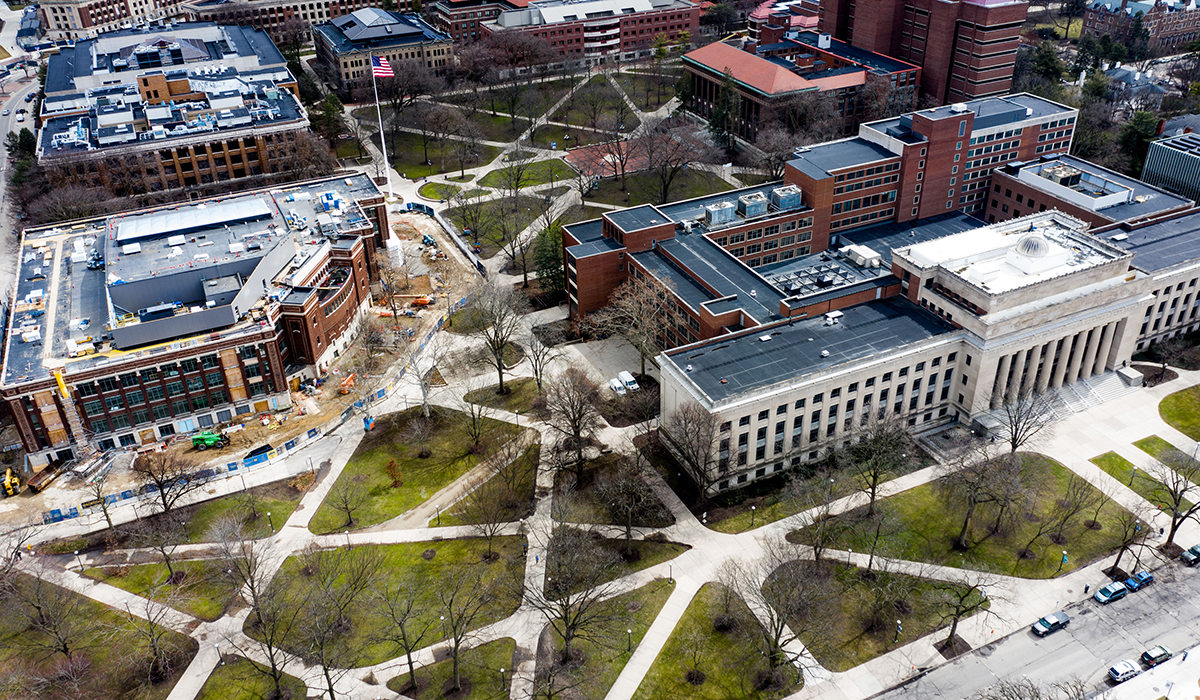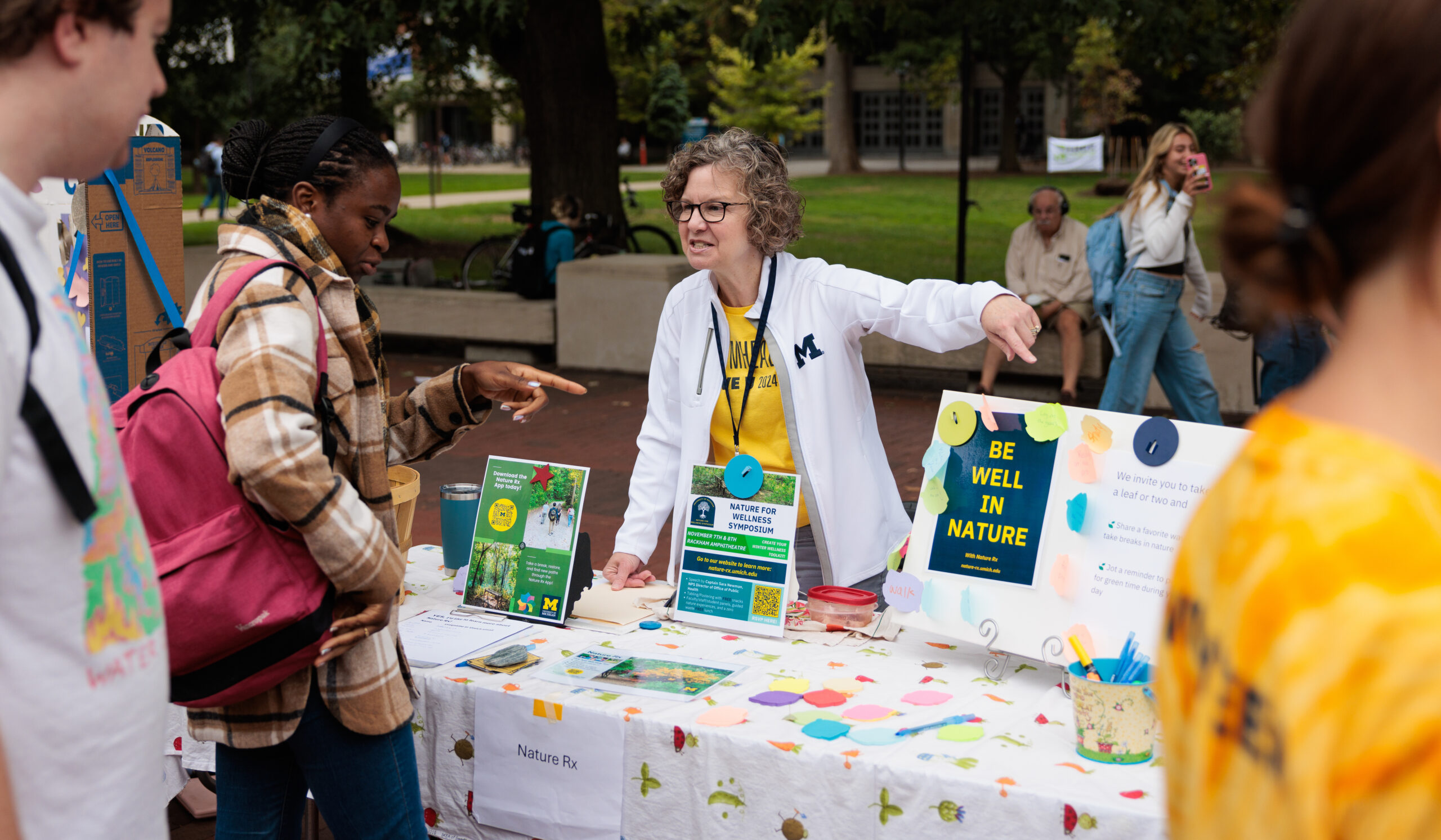The arrival of COVID-19 into the world meant the departure of students, faculty, and staff from campus. In the immediate aftermath of that emptying-out, everything changed for members of the U-M community. These essays were written shortly after that happened.
A Series of Firsts and Lasts
U-M faculty and students had just returned from winter term break when, only days later, they learned they would leave campus again. David Gerdes, professor of physics and astronomy and chair of the Department of Physics, tells of the impact on his work.
BY LATE FEBRUARY, my wife and I were ready to escape the Michigan winter, so we boarded a flight to Arizona that was jam-packed with pallid fellow Midwesterners. The strange new virus that had been sickening people in Wuhan, China, had not yet spread widely in the U.S., but its imminent arrival felt inevitable.
A faculty colleague on sabbatical in Italy sent us alarming reports of her family’s life under quarantine. With just a few days’ notice, my professional society made the unprecedented decision to cancel its annual March meeting, where 10,000 physicists from around the world would have gathered. Universities were debating the wisdom of continuing classes. If American society had been a character in a Warner Brothers cartoon, it would have been standing on a large red X beneath a growing, anvil-shaped shadow.
In Arizona, we continued to do normal things: eating out, visiting parks, going shopping. We also stopped by the 4-meter telescope at Kitt Peak National Observatory, where a team from U-M is commissioning a major new instrument to study the cosmos. On the flight home, a few people were wearing masks.
We returned to a rapidly developing crisis. It didn’t begin with a single, searing moment like the 9/11 attacks, frozen indelibly in memory. Instead, it unfolded as a series of firsts: The first time I wore protective gear to go grocery shopping. The first time I ran a faculty meeting via video. The first time I used the word “serology.”
As the “firsts” have become routine, the “lasts” — often unnoticed at the time — now seem even more poignant: The last time I went out to dinner with friends. The last time I dropped my son off at school.
And the last day my students and I gathered in our classroom.
Many universities had already announced that they were moving classes online for the remainder of the semester, and U-M seemed certain to follow. I told my students that it had been my pleasure to get to know them and that we would navigate the coming uncertain weeks with flexibility, compassion, and generosity.
I’ve never been prouder to be a Michigan faculty member than I was that semester. Classroom teaching comes naturally to us — we’ve been doing it our whole careers. Remote teaching posed a completely new set of challenges that had to be met in just a few days, amid the hectic closures of schools, daycare centers, and our own research labs. Yet somehow it all worked, at least well enough, with remarkably few glitches. Faculty, students, and staff showed incredible creativity, commitment, and patience.
Our COVID-19 adaptations will eventually bring enduring benefits to the ways we engage with each other. But for now, the loss of connection through our shared intellectual life on campus is real and painful. Research facilities, including the telescope in Arizona, are still closed. Economic damage will reverberate for a long time. Many will suffer grievous personal loss. I will look forward to happier “firsts” when we come out the other side of this.
A Race to Sustain
As a U-M junior, Elizabeth Lawrence faced the abrupt end of in-person classes like all other students. As editor of The Michigan Daily, she faced the immediate task of planning how to keep the newspaper going in a new, virtual setting.
BY THE TIME U-M’S SPRING BREAK ARRIVED in late February, I felt as if I’d dragged myself, panting, to the halfway point of a marathon that would soon continue. During the previous two weeks, the news editors and I had overseen coverage of numerous allegations of sexual misconduct. I had stress dreams about Michigan’s quickly approaching presidential primary. And something had vaguely been on my radar since January: coronavirus.
Nevertheless, I took advantage of the break as much as I could, editing breaking news stories here and there before classes resumed on March 9.
The following day — primary day — it steadily dawned on me that the impact of COVID-19 in the U.S., which I’d semi-ignored for months, was rising like a freakish tidal wave. Colleges across the country were closing their doors, governors were imposing lockdowns, and sports seasons were being canceled. Kathy Ciesinski, the general manager of U-M’s Office of Student Publications, emailed me and The Daily’s business manager, Anita Michaud. We needed to discuss backup plans.
We met the next day, after Michigan Gov. Gretchen Whitmer had declared a state of emergency. In that meeting with Kathy, as words like “stopping print” and “remote production” were thrown around, I felt a rising sense of dread. I checked my phone — my last class of the day had been canceled. It would have been my last in-person class of junior year.
I went up to the newsroom, where a group of staffers had assembled. Smiling grimly at them, I headed to my desk and began an email to staff: my first “in these trying, crazy times” email of many to come. Before I hit send, the inevitable happened. U-M President Mark Schlissel announced that all classes were to be moved online for the remainder of the winter semester.
That night, the paper’s managing editor, Erin White, and I announced to the staff that The Daily’s last print edition would be, fittingly, on Friday, March 13 — there was no point printing a paper no one was around to read. Our last in-person production would be Thursday night, and after that we would coordinate our important work remotely through Zoom and Slack. Though staffers were upset, they immediately got to work. The design team coordinated remote InDesign instructions, and the social media team informed our followers how to keep up with The Daily. Photo editors created a photo essay schedule, and sports editors pitched feature ideas. The news team pivoted to varied, compelling coronavirus coverage.
We published a PDF version of our paper every weekday for the rest of the semester. All 200 of us gathered virtually to elect Emma Stein our summer editor-in-chief and Brittany Bowman our summer editorial page editor. They’ve taken over as of April 21.
During our last night together in the same room, we embraced our in-person newsroom silliness. We filmed ourselves dancing, we dove into The Daily’s archives in search of 1918 flu coverage, and we sang “Electric Love” by BØRNS. I sent the pages to the printer, took a deep breath, and turned off the newsroom lights with Erin and whoever else had stuck around to the bitter end. I tried not to feel too sad, though. I had many nights of production ahead, and a race to sustain.
End of the Season
The impact of the coronavirus reverberated across campus when in-person classes ended. Among those affected were athletes and their coaches, including head softball coach Carol Hutchins. This is adapted from “U-M Athletics and COVID-19: Oral History of Week That Changed Everything” by Steve Kornacki and Brad Rudner on mgoblue.com.
FOR U-M’S STUDENT-ATHLETES, the week of March 9 began normally. They attended classes, anticipated upcoming competitions. But with the news of the coronavirus’s rapid spread across the globe, they had a deepening sense that those plans could change at any time.
On March 12, head softball coach Carol Hutchins was going through a hitting drill with three upperclassmen, including senior third baseman Madison Uden.
“I could tell they were concerned over all of this, and so I asked them what their biggest concern was,” said Hutchins. “I didn’t know if they were going to say their families or what, but Maddie said, ‘I’m afraid we’re going to lose our season.’”
Hutchins had to leave practice upon learning of a 3 p.m. head coaches conference call with athletic director Warde Manuel. She found herself hoping for only a one-month shutdown of the season, which was off to a 15-8 start.
Manuel informed everyone that the Big Ten had canceled the rest of the winter and spring sports schedule. About 90 minutes after that, NCAA president Mark Emmert announced that the remaining 2019-20 NCAA championships were canceled.
Hutchins returned from the call, knowing the entire season was over. Watching practice from seats near home plate at Alumni Field, she was impressed by the energy and carefree attitude of her team despite the weight they carried on their shoulders. She let her assistants finish drills before joining the team to add a squeeze-bunt drill; she then called everyone together in the home dugout on the first base line.
“I just said, ‘There’s no good way to tell you this, but this is the deal on the season: It’s just been canceled.’ They were a very heartbroken group. We were all emotional. I mean, what else could they be? They were shocked.
“I tried to give them words of encouragement and hope: ‘This is OK; we’re going to be OK.’ I urged them not to judge these decisions because there are no decisions here. ‘We have got to do what it takes. It’s uncharted water for the entire world. We have got to do our part, and our part is to do what they tell us to do. Let’s do what the scientists tell us to do.’”
A few days later, Hutchins returned to Alumni Field. It was cool and clear, not bad weather for March 14, the scheduled date of the team’s home opener against Ball State.
“I went and just stood in the dugout. And I feel I have to be a strong leader, but it was like, ‘What am I going to do?’ I coach this time of year. This is so far beyond my control and my sport.”
However, Hutchins has come to grips with the cancellation of the sports schedule for this academic year. The COVID-19 pandemic has been life-changing and will have lasting effects.
“The NCAA did the absolute right thing. In my opinion, we were leaders, and we had to do our part. I thought (associate head coach) Bonnie Tholl put it best when she said the seniors’ greatest moment was giving up their season and saving lives by all those events that were not played.”
Fighting Against Fear While Helping Patients
When the state of Michigan announced its first COVID-19 patient on March 10, Tammy Chang’s world turned upside down. The family physician and researcher had to learn new ways to care for patients.
AS A PRACTICING FAMILY PHYSICIAN and researcher at Michigan Medicine, the impact and gravity of coronavirus has reshaped my work life.
During the first weekend after the COVID-19 alarms had been raised in our community, people were understandably nervous and scared. Patients had many reasons for wanting to be tested. I had to tell nearly everyone that they didn’t qualify for testing — yet.
Some patients with true emergencies refused to go to the emergency room for fear they would be infected. And some elderly patients who needed to be seen by a doctor or pick up a prescription couldn’t because their adult children and support people were under quarantine. No one was left to help them.
On Mondays, I typically see patients at a clinic that specializes in caring for teens and young adults. It was there that I received an email about social distancing, staying 6 feet away from others. I sent my medical student home. The trigonometry of three people trying to stand 6 feet apart in an exam room is impossible.
The clinic staff had converted in-person visits to “phone visits.” After a few conversations, I felt encouraged about the ease of virtual visits and how happy the patients seemed with this new way to connect. I was starting to feel as if this could work. Helping patients, while flattening the curve.
Soon after, I got an email saying that the University had suspended all medical student clinical rotations. Whew! One less risk for transmission, as the staff worked to balance patient care and public health.
Another email notified our clinic that, like other health systems, we were ending all non-urgent visits. All patients were categorized into (1) urgent and needing to be seen in person, (2) urgent but can be evaluated by video or telephone, or (3) safe to postpone for six to eight weeks.
I know that talking to my patients by phone allows me to connect with them personally and provide reassurance and care. At the same time, all evidence shows that the pandemic is going to get worse before it gets better. For the first time, I gave patients my personal cellphone number.
Clinical care is changing faster than at any other time in my career. I consider how skeptical people were before COVID-19 that telemedicine visits could be acceptable because of ethical, privacy, and billing concerns. Yet, in less than a week, video visits were up and running.
Underlying all of these rapid clinical changes is a gnawing fear about bringing the virus home. My partner, who is also a physician, and I have had difficult conversations with our kids, including what happens if one or both of us get sick. We tell them that it’s important to be strong and help each other at home because we are a family. “I hate coronavirus,” my daughter says. “Me, too,” I think to myself.
Family physicians are trained to recognize that people’s relationships, emotions, and responsibilities affect their health. For me, the consequences of the COVID-19 response are becoming apparent. As one frustrated patient who cares for her elderly mother told me, “My mom may die of the virus, but without work, we could starve. I don’t know what I’ll feed my kids.”
Situations like social isolation, worsening mental health issues, job loss, loss of health insurance, and food insecurity are all issues I have heard about from my patients, friends, and family. The COVID-19 pandemic is our current public health emergency, and it’s deadly serious. But I worry that the aftermath may be just as bad. We need to plan for it.





